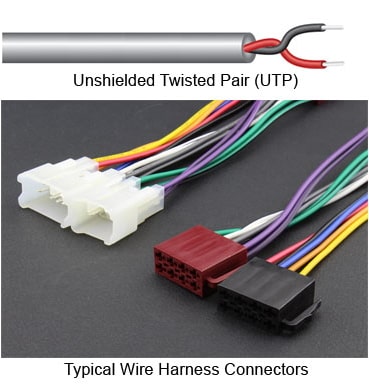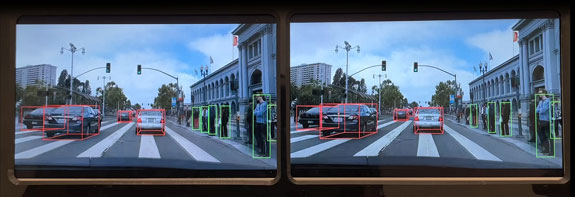Automotive High-Definition Link (AHL) is a new video transmission technology designed to reduce the cost of transporting high-resolution video from the camera to the ECU. Over the past several years, rear-view cameras have become standard equipment on most vehicles around the world. As drivers experience the benefits of an expanded field of view behind the vehicle, OEMs want to increase that capability to include viewing the entire area around the vehicle. These Surround View Systems have become an extremely popular parking assistance feature and normally consist of four or more cameras strategically placed to provide a complete 360° view of the area immediately around the vehicle.
Surround view systems are primarily offered in more expensive vehicles because higher resolution cameras are needed to provide a good surround view image. The cost of High-Definition (HD) camera systems is ~30-40% higher than traditional Standard-Definition (SD) camera systems primarily due to the expensive nature of the cables and connectors necessary to facilitate uncompressed digital video transmission. AHL can use inexpensive cables and connectors such as unshielded twisted pair (UTP) and traditional wire harness connectors.

Figure 1. Cable and Connector Images - UTP (top), Typical Wire Harness Connectors (bottom)
To facilitate a cost-effective camera implementation in the vehicle, Renesas designed a technology that leverages the low-cost infrastructure used in traditional analog SD camera systems, while providing the picture quality and higher resolutions desired in today’s applications. AHL transmits HD video as a modulated analog signal, similar to the way old-fashioned CVBS analog SD video was transmitted. AHL transmits HD video at a frequency just under 40MHz, whereas uncompressed digital video transmission serializer links utilize frequencies at or above 1.5GHz. These high-frequency digital transmissions require the use of heavily shielded cables and dedicated high-end, expensive connectors that have very strict impedance matching requirements. OEMs found that these digital serializer link connectors can age differently, depending on their location in the vehicle, resulting in shifts to each connector’s impedance characteristics causing a mismatch between connectors. When this happens, the video transmission no longer works and all connectors in that cable run must be replaced to regain the necessary impedance matching.
Another type of digital transmission uses compressed video to reduce the transmission bandwidth, however, this approach requires additional processing power in the camera, which adds to the cost, increases power consumption, and the size of the camera module itself. More importantly, compressed video introduces several frames of latency into the video transmission. This isn’t a problem when watching movies at home, but in the automotive market, even the smallest amount of latency introduces risk in driving applications.
Analog video transmission has no latency and a relatively low transmission bandwidth resulting in significantly simpler and less expensive cable and connector requirements than digital links. When implementing AHL, OEMs have the option to re-use their existing SD analog cable and connector infrastructure. The RAA279972 AHL video decoder can decode traditional NTSC standard-definition video, so OEMs have the flexibility to offer an SD camera system with the base trim option. If the customer upgrades to a premium trim, an HD camera system can be offered by simply changing the camera module from a VGA resolution sensor to an HD sensor with a RAA279971 AHL Encoder integrated into the camera module. The cables and connectors, as well as the hardware in the ECU where the video is received, do not change. This is a seamless and cost-effective way for OEMs to offer an upgrade path to their customer base with minimal changes to their existing infrastructure. By lowering the cost of implementing HD video camera systems, Renesas is helping to expand and accelerate the adoption of HD video into a wider range of vehicles including economy models.
AHL also has unique features to improve the reliability and functionality of parking assistance camera systems. One of these is a full-time, bidirectional Control Channel that is independent from the video data but utilizes the same wires as the video. Since the control channel does not require active video to operate, the system can be configured to program and initialize the camera from the ECU at start-up. It can also be used to monitor the camera during operation and change camera settings on the fly to adjust for changing lighting conditions or to avoid overheating. AHL also has built-in image enhancement capabilities to maximize the image quality, and diagnostics to detect short-to-battery and short-to-ground events, loss of signal, and gauge the quality of the transmission.
While demonstrating the video content transmitted by AHL, customers could not tell the difference between digitally transmitted video and AHL video. Renesas took this comparison to the next level by running AHL video through advanced object recognition software. The results show the performance of computer vision algorithms with AHL video had a +/-1% difference in detection and recognition accuracy when compared to digital video content.

Figure 2. Advanced Object Detection and Recognition Video Comparison between AHL and Digital Transmission
AHL supports MIPI-CSI2, DVP and BT.656 interfaces as inputs on the RAA279971, and as outputs on the RAA279972. It transmits excellent video quality at distances up to 30 meters with multiple in-line connectors. Renesas has user-friendly evaluation boards, application notes and IC samples available upon request.
For more details, visit the RAA279971 encoder web page, and the RAA279972 decoder web page.
